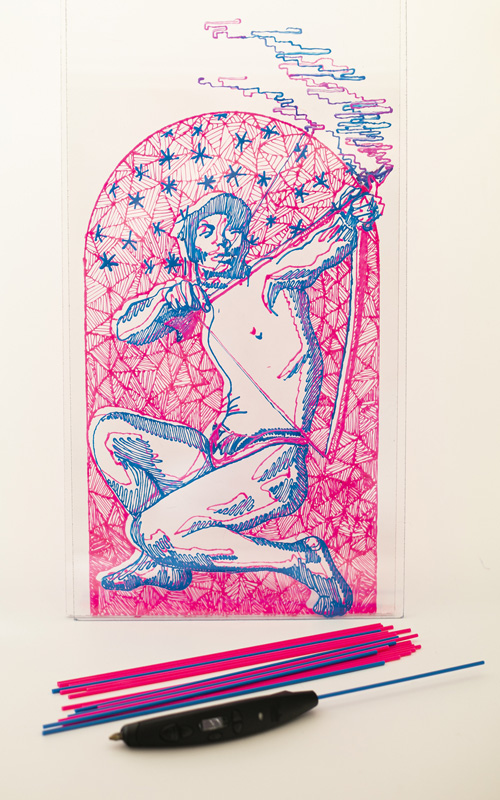Street art is created in public locations and is usually unsanctioned. Still, it covers a wide range of media and is generally more connected with graphic design than graffiti art, according to Tate.
3Doodler took inspiration from this art form in our latest collaboration with artist Ricardo Martinez. Creating this street art design, Ricardo took inspiration from 3D glasses, engraving, and a late Mexican artist.
3D Glasses & Pop-Culture
Ricardo admits that inspiration for his latest piece initially took a lot of work to find. Although the ideas were there, they took time to coalesce into a design.
“I knew I wanted to create an anaglyph. I kept thinking about 3D glasses that had one red and one blue lens,” said Ricardo. “The images were layers and when you viewed them through the glasses, your perception would change making the image pop off the page or the screen.”
Joseph D’Almeida experimented with anaglyphs, a Greek term meaning again and sculpture, in the 1850s and is often credited with inventing a new way to view 3D. Anaglyph uses a motion or still picture in which two composite images, usually one red and one blue, are superposed one over the other to produce a three-dimensional effect when viewed through correspondingly colored glasses.
The Power of Love, released in 1922, was the first movie to use anaglyph technology and require the audience to wear 3D glasses. It grew in popularity, and more films were released in the 1950s. One of the more well-known films of the time was Creature From The Black Lagoon in 1954.
A more current example of the technique that Ricardo referenced is this Daily Motion video that shows street mural art with two designs in one, depending on how you view it.

Late Mexican Artist Inspires Modern Design
Despite having chosen his technique, Ricardo struggled to find inspiration for the piece itself. As he attempted different designs, nothing looked quite right. Ricardo wanted to create a transparent image with plexiglass panels. He started with a heart, but the idea refused to take shape.
Ricardo looked for a piece of art or another idea to inspire his design. He decided to focus on a Mexican artist he greatly admired, Saturino Herrán. Born in Aguascalientes, Mexico, on July 9, 1887, Herrán attended the Academy of San Carlos in 1904. His artistic career flourished from 1912-1914, inspiring the Mexican modernist movement.
“I’ve always admired Herran’s figurative art,” said Ricardo. “He is not really well known and I wanted to pay tribute to him using new technology. It felt especially powerful given I’m working with a drawing that is easily 100 years old and reviving it in a modern way.”
The work that inspired Ricardo is an unnamed illustration that Herran drew for Pegaso magazine in 1917. Herrán’s more famous works include Our Ancient Gods, which celebrates the strength, dignity, and beauty of the indigenous people who are part of Mexico’s history. Through this painting and several others, Herrán established himself as a champion of indigenismo, a movement to elevate and show respect for Indigenous people and their culture.
Creating Street Art
Now that Ricardo had his idea for the drawing and the technique he would use, he was ready to create. First, Ricardo would trace the sketch and then use his artistic design elements to fill in the back of the portrait.
“What many people don’t realize is that with a 3Doodler 3D pen, you don’t have to be a great artist or designer to create something beautiful,” said Ricardo. “You can find inspiration in drawing or sketches you see and use a DoodlePad to trace them and create art.”
The bright pink and blue palettes he used were classic street art shades. The final design is something that Ricardo is pleased to share.
“When you have an idea, you should see it through to the end. As I was working on this piece, I wasn’t happy with it at all. I even stopped at one point as it just wasn’t making sense,” said Ricardo. “Seeing it through to the end paid off as I was able to realize my initial vision.”
Ricardo’s advice to other artists is to stick with it.
“Even if the skills aren’t there, you can trace. Do whatever you can to produce something and your own style will start to emerge as you put pen to paper,” said Ricardo.








